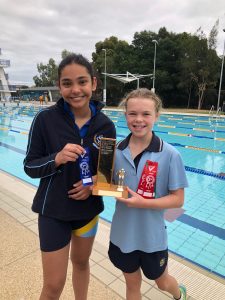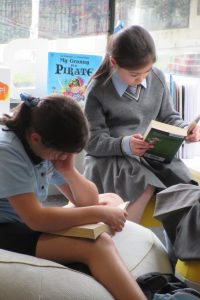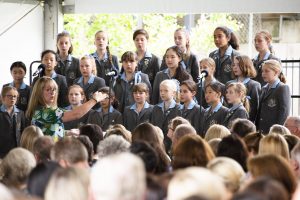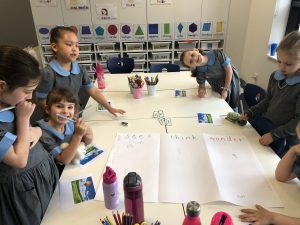Improving Your Daughter’s Vocabulary

Improving Your Daughter’s Vocabulary
One of the key indicators of a student’s success in school, on standardised tests, and indeed, in life, is their vocabulary. The reason for this is simply that the knowledge anyone has about a topic is based on the vocabulary of that information (Marzano & Pickering, 2005).
Researchers Hart and Risely (1995) state that the biggest difference of children entering school is economic, not race, ethnicity or gender. They argue that the greater and higher levels of vocabulary used in more professional families leads to children having better vocabularies and understanding of the language, and ultimately greater knowledge and success.
The range in children’s exposure to vocabulary across a year can vary from 30 million – 10 million words depending on the level of conversation in the family and value placed on reading in the family.
What can you as parents do to increase your daughter’s vocabulary?
- Read, read, read to your daughter.
- Read non-fiction books about topics they are interested in.
- Go to museums, science centres – anywhere they will be exposed to new vocabulary.
- Talk about words, what they mean and how they can be used.
- Speak to your daughter as an adult and use adult language – continuing to use simple language does not help her grow and develop a great vocabulary.
- Have fun with words – choose a word and make a game of it e.g. how many times can I use that word properly in sentences in the next hour.
- Show your daughter how to use a dictionary and thesaurus.
- Show your daughter how to find synonyms (words that mean the same) on the computer so they can use better words (we call these Tier Two words).
- Play crosswords together.
Teachers work hard to develop the vocabulary of students. Each unit of work for each subject introduces new vocabulary for the students to learn. We also encourage girls to include this vocabulary in their writing or when editing. This year we will be introducing Tier words. The idea is that there is a hierarchy of words we can use. Tier 1 words are everyday words, Tier 2 words are better choices than everyday words e.g. using ‘relied’ rather than ‘said’, and Tier 3 words are subject specific e.g. ‘herbivore’.
Official Opening of Barbreck
The Official Opening of the Junior School – Barbreck was a momentous occasion with the girls’ involvement a key feature of the ceremony and activity around the Opening. Congratulations to our Junior School Captains, Audrey Doan and Chloe Favaloro, for speaking so eloquently in the formal part of the ceremony, and to the girls who presented the Governor with gifts – it was such a moving tribute to all things Barbreck.
Congratulations also to the Epstein Singers and Mrs Lyn Henshall, Mrs Melissa Dods and Mrs Kate Denmead who performed so beautifully and to all of the girls for the craftsmanship they showed in creating the ceramic garden creatures which will be featured on the garden wall.
A huge amount of careful planning and thinking goes into creating such events and many of the staff give generously of their time to ensure the girls are showcased and shine on the day. Thank you to everyone who played a part in this.
It was wonderful to have Her Excellency, the Honourable Linda Dessau AC, Governor of Victoria, a former Barbreck girl, officially open the new building. She presented as a strong, well educated, confident and successful woman – a great role model for our girls. The girls loved to hear about her times at Barbeck and how much the School has changed and improved.
Swimming Champions!
It was a day when great coaching, team spirit and sheer determination came togther to produce a marvellous result. The St Catherine’s District Swimming Team came 2nd overall against some tough competition but won the Population Trophy when taking into account school size. Congratulations to the girls and coaches, and special mention to the Swimming Captains Annabel Taylor (Year 6) and Ariana Rajan (Year 6). I was not sure who was more excited, the parents who attended or the swimmers themselves! Overall it was an exciting and highly rewarding day.

The Junior School Swimming Captains Annabel Taylor (Year 6) and Ariana Rajan (Year 6) with the Population Trophy.
Ms Karen McArdle, Head of Junior School
‘See, Think, Wonder’
See, think, wonder is a thinking strategy that encourages students to make careful observations and thoughtful interpretations. It helps stimulate curiosity and sets the stage for inquiry. It is a powerful way to delve deeper into what initially is seen as a simple image. From the image above, we were able to collate many suggestions about what we could see in the picture, what we thought it was and what we wondered about it. Some of the suggestions included ‘It has a large dome’, ‘I can see lots of balloons’, ‘I wonder where it is?’ and ‘What is the top of it called?’.
In case you are wondering what this magnificent building is, it is the Hagia Sophia, once a Greek Orthodox Cathedral built in 537 AD and now a museum in Istanbul, Turkey.






